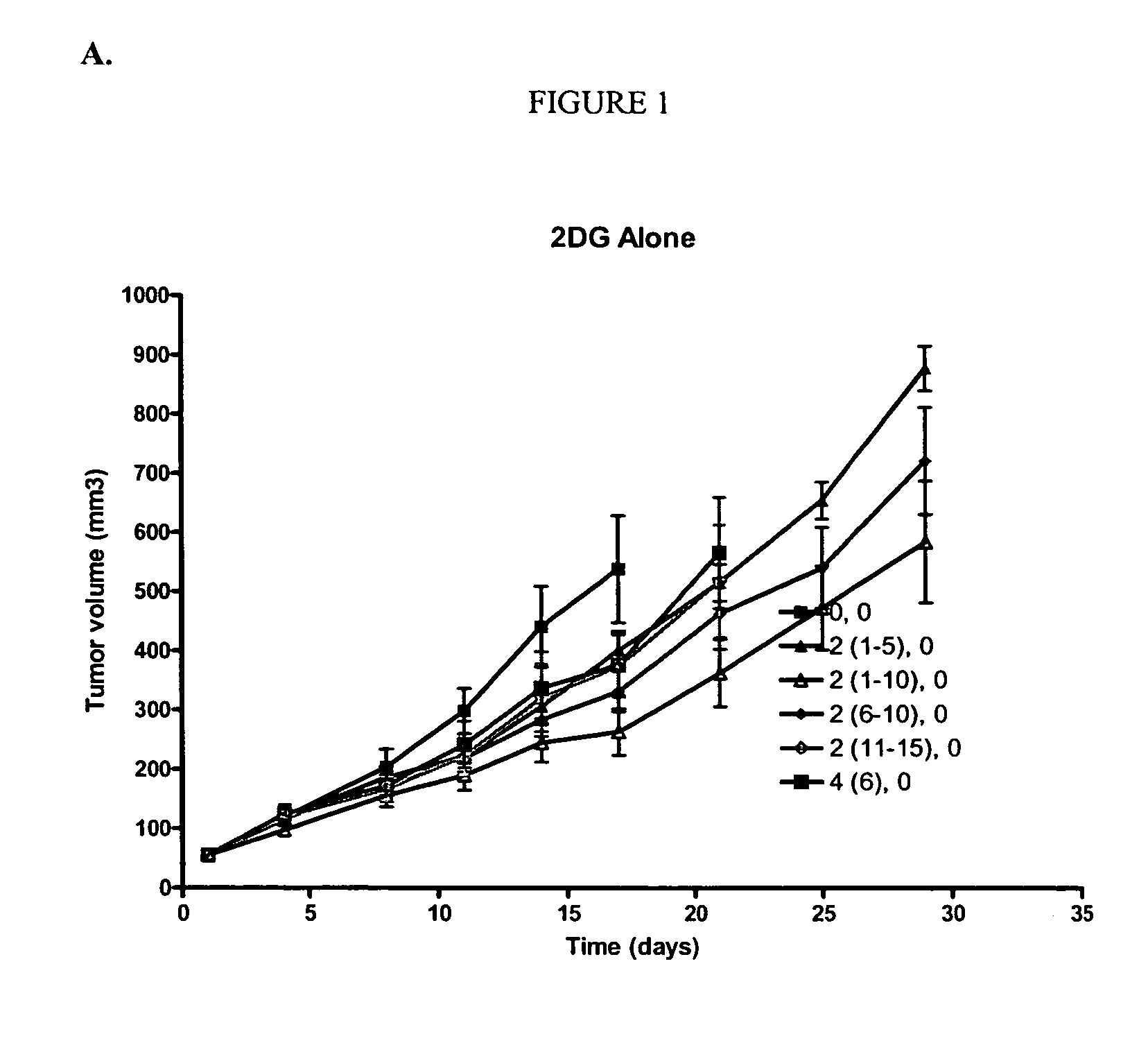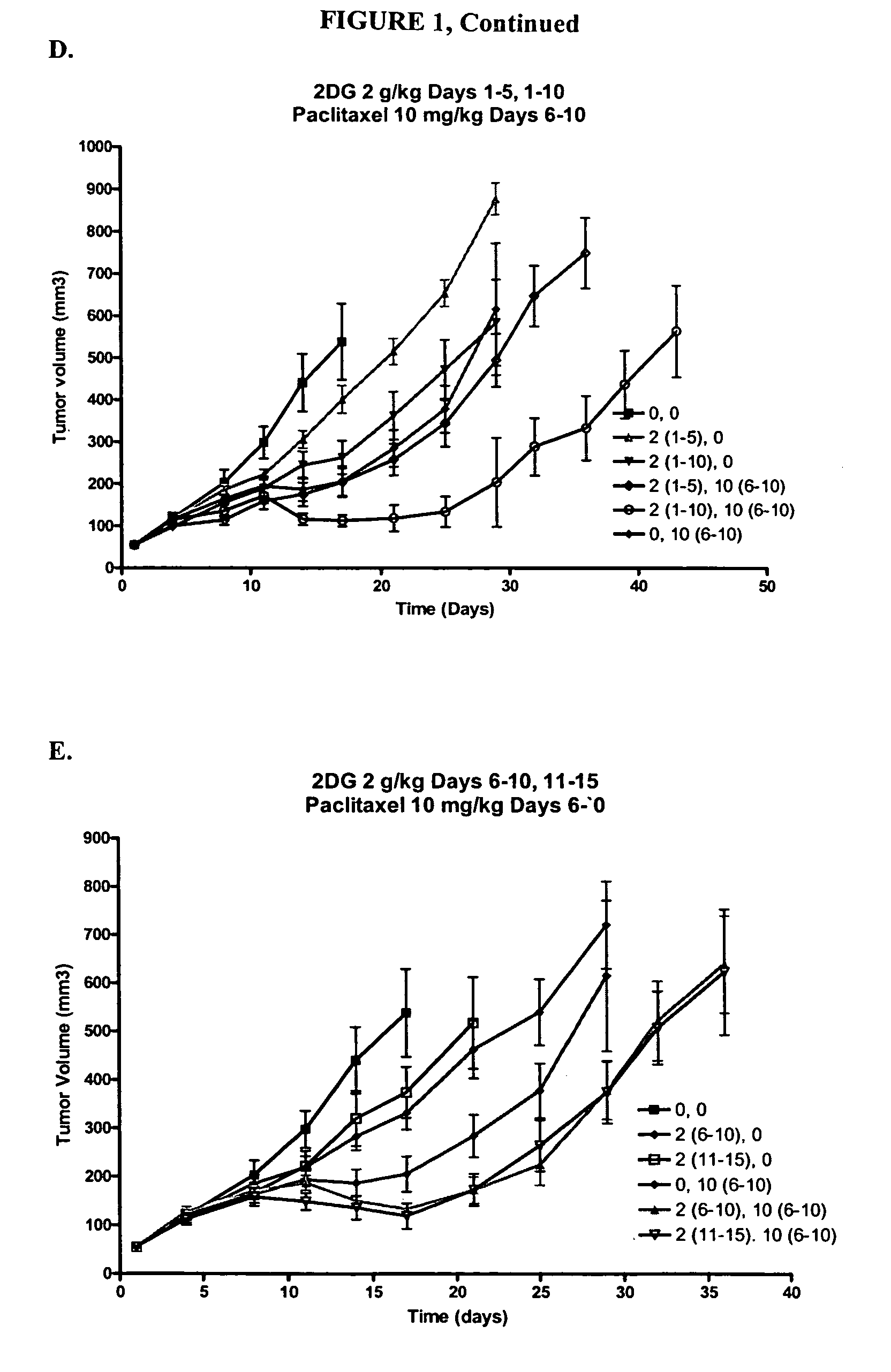Treatment of cancer with 2-deoxyglucose
a cancer and deoxyglucose technology, applied in the direction of biocide, drug composition, dispersed delivery, etc., can solve the problems of not killing all cancer cells in the patient, unable to generate the energy required, and cancer a deadly diseas
- Summary
- Abstract
- Description
- Claims
- Application Information
AI Technical Summary
Benefits of technology
Problems solved by technology
Method used
Image
Examples
example 1
Growth Inhibitory Activity of 2-Deoxy-D-Glucose Against Human Non-small-cell Lung Carcinoma Cell Lines
[0135]In this example, 2-deoxy-D-glucose (2-DG) was demonstrated to inhibit two cell lines obtained from human non-small cell lung carcinomas (NSCLC). The human lung tumor cell lines were MV522 and NCI-H23, both of which were derived from tumors displaying histopathology of adenocarcinoma, one of the at least three types of NSCLC. The NCI-H23 tumor cell line is available from the ATCC (Rockville, Md.), and the MV522 cell line was obtained by Dr. M. J. Kelner of the University of California. The cells were cultured in RPMI medium (Nova Tech, Grand Island, N.Y.) at 37° C. in a humidified atmosphere containing 5% CO2. For passaging, cells grown in 75 cm2 flasks (60–70% confluency) were washed with PBS and dislodged from the flasks with trypsin (Gibco BRL) before being passaged. Cells used for the experiments described below were centrifuged and resuspended in cell culture medium at a c...
example 2
Evaluation of 2-DG as a Single Agent and in Combination with Cisplatin and Paclitaxel
[0139]The efficacy of 2-deoxy-D-glucose (2-DG) was tested alone and in combination with cisplatin and compared with cisplatin alone in a tumor growth delay study in a mouse MV522 xenograft model as follows. Female nude mice (nu / nu) between 5 and 6 weeks of age and weighing approximately 20 g were obtained from Harlan, Inc. (Madison, Wis.). Animals were implanted subcutaneously by trocar with fragments of Mv522 human tumor carcinomas harvested from subcutaneously growing tumors in nude mice hosts. When the tumors were approximately 71 mg in size (11 days following inoculation), the animals were pair-matched into treatment and control groups. Each group contained 10 tumored mice. Each mouse was ear-tagged and followed individually throughout the experiment. Initial doses were given on Day 1 following pair-matching. 2-DG was administered orally (p.o.) on a 12-hour twice daily×5 to end (bid×5 to end) sc...
example 3
Oral Formulations of 2-DG
[0153]This example illustrates the preparation of representative pharmaceutical formulations for oral administration.
[0154]A. 2-DG is dispensed into hard-shell gelatin capsules containing between 100 mg and 1 g of 2-DG; optionally, about 0.5% (weight / weight) magnesium stearate can be added. In addition, a mixture of 2-DG and lactose can be used in the capsule.
[0155]B. 2-DG (20.0%–89.9% wt. / wt., depending on whether lactose is present, and how much); magnesium stearate (0.9%); starch (8.6%); optionally lactose (0–69.6%) and PVP (polyvinylpyrrolidine; 0.9%) are, with the exception of the magnesium stearate, combined and granulated using water as a granulating liquid. The formulation is then dried, mixed with the magnesium stearate and formed into tablets with a tableting machine.
[0156]C. 2-DG is dissolved in a mixture of propylene glycol, polyethylene glycol 400, and polysorbate 80; water is added; and the resulting mixture is dispensed into bottles.
[0157]D. A...
PUM
 Login to View More
Login to View More Abstract
Description
Claims
Application Information
 Login to View More
Login to View More - R&D
- Intellectual Property
- Life Sciences
- Materials
- Tech Scout
- Unparalleled Data Quality
- Higher Quality Content
- 60% Fewer Hallucinations
Browse by: Latest US Patents, China's latest patents, Technical Efficacy Thesaurus, Application Domain, Technology Topic, Popular Technical Reports.
© 2025 PatSnap. All rights reserved.Legal|Privacy policy|Modern Slavery Act Transparency Statement|Sitemap|About US| Contact US: help@patsnap.com



